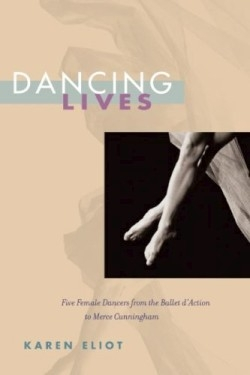
Dancing Lives
Five Female Dancers from the Ballet d'Action to Merce Cunningham
“Exciting her spectators with her physical beauty and seductive playfulness as well as her great control and acumen, Baccelli danced with fleet, delicate steps in clearly etched patterns through space, her face always expressive and alive,” Eliot writes.
Giovanna Baccelli, an eighteenth century ballerina, is one of five dancers Eliot discusses in this historical account, which emphasizes each dancer’s personal and professional life and highlights the social, economic, and political issues affecting their careers. Eliot is a professor of dance at Ohio State University and former member of the Merce Cunningham Dance Company. In addition to Baccelli, she profiles Adele Dumilatre (1821-1909), Tamara Karsavina (1885-1978), and Moira Shearer (1926-2006) who all achieved celebrity as ballet soloists. Eliot ends her account with Catherine Kerr (1948- ) who was a longtime member of the Merce Cunningham Dance Company.
Eliot describes how each dancer embodied the aesthetics of her era. Her narrative focuses on the technique, training, and performance attributes of these soloists while revealing their secondary status as interpretive artists. Adele Dumilatre epitomized the Romantic Ballet’s notion of dance through her technical virtuosity and grace. Tamara Karsavina served as one of the most famous soloists of Diaghilev’s legendary Ballet Russes. In spite of their dedication and adaptability to the demands of the choreography, however, their careers were often eclipsed by their male colleagues or other female icons of dance. Moira Shearer, best known for her role in the 1948 movie The Red Shoes, was always compared to the prima ballerina Margot Fonteyn. Yet it was Shearer who created an American audience for ballet through her alluring film presence.
Too often dance is documented only by the finished artistic product. Eliot offers an alternative to this form of recorded history by focusing on the embodied experience of specific dancers. The physicality of each dancer is discussed in relationship to the choreography. Eliot’s account of Catherine Kerr’s role in the making of Merce Cunningham’s choreography reveals the extent to which the dancer’s physicality plays an important role in shaping the choreographic vision. Cunningham often chose Kerr as his partner and created numerous roles for her utilizing her balletic technique and her deftness in mastering his own style. Not unlike her eighteenth-century counterpart Giovanna Baccelli, Kerr impressed her audience with her exquisite interpretive skills.
Spanning the time between the late eighteenth century and the mid-twentieth century, Eliot recalls dance through the exciting physicality of the female body. An engaging read for all those who enjoy the ephemeral qualities of dance.
Disclosure: This article is not an endorsement, but a review. The publisher of this book provided free copies of the book to have their book reviewed by a professional reviewer. No fee was paid by the publisher for this review. Foreword Reviews only recommends books that we love. Foreword Magazine, Inc. is disclosing this in accordance with the Federal Trade Commission’s 16 CFR, Part 255.
